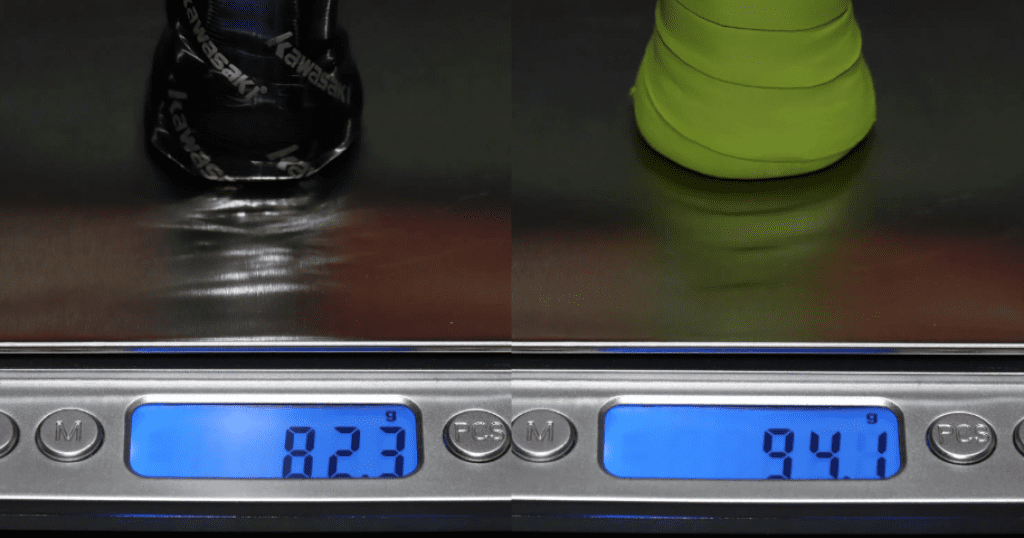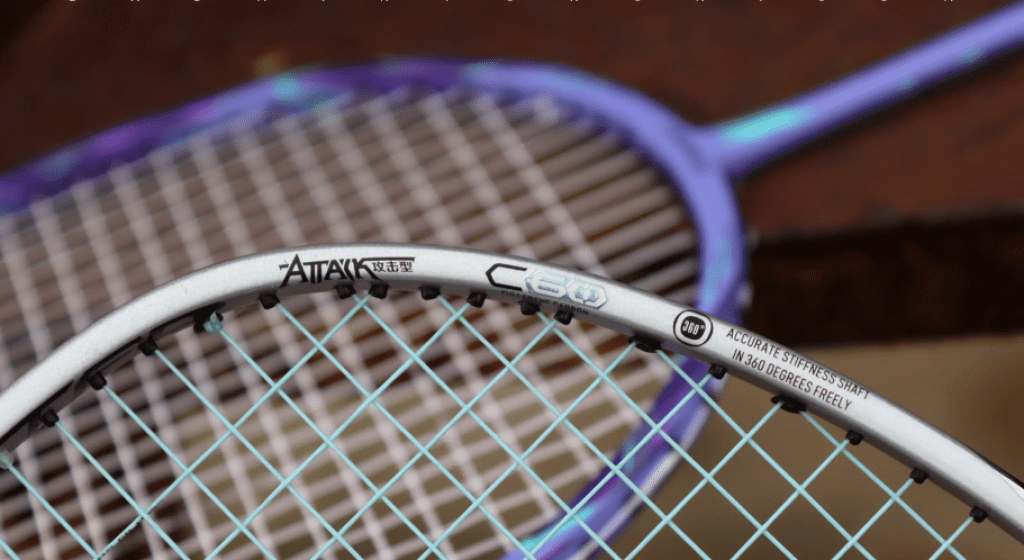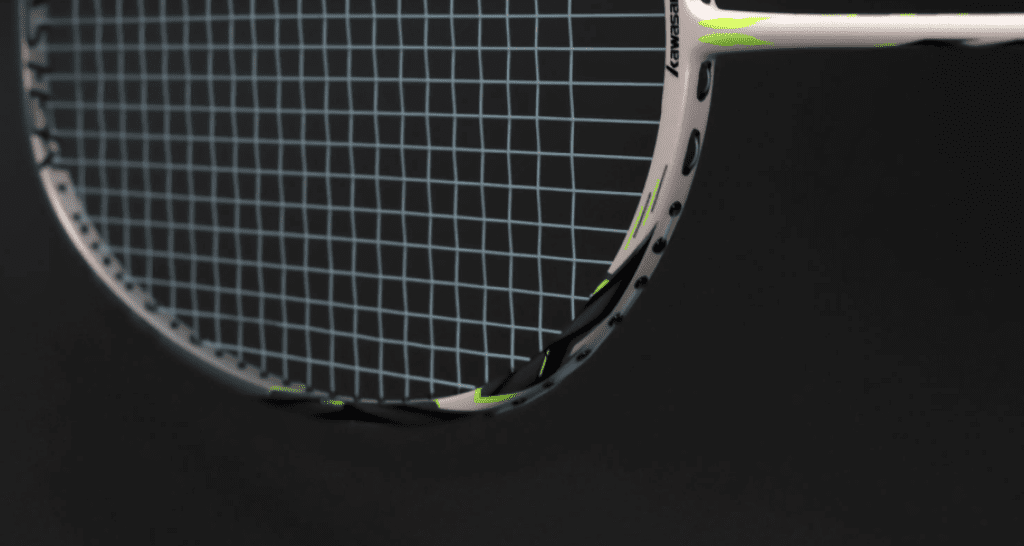
46T, 30T, C60 Fullerene—these are cutting-edge technological labels in the badminton racket world. It wouldn’t surprise me at all if they appeared on a Kawasaki racket. But what if they were featured on a mid-range, box-framed singles racket known for its stability within Kawasaki’s lineup?

Perhaps it’s a preconceived notion, but in my understanding of the Kawasaki brand, most of their rackets are designed for doubles, with innovative and unique frame shapes that prioritize speed. On the other hand, singles rackets focused on stability and offense are something I’ve rarely heard of. The traditional, box-framed structure aimed at steady offensive play seems to predestine these rackets to an overall “mediocre” feel. However, Kawasaki has now introduced a racket named “Time Traveler” as part of a new series. I had recently tested the “Time Traveler” shoes from the same series, and both the shoes and the racket form a cohesive system. This time, I’ll be sharing my experience with the “Time Traveler” racket, which not only boasts a high aesthetic appeal but is also part of Kawasaki’s five-star Master Series. With cutting-edge technology combined with a retro box frame, does this pique your interest?

Appearance
The Kawasaki Time Traveler comes in three different color schemes: white-grey, dusk blue, and grey-green. Despite the different colors, the specs are consistent across all variants. The entire racket is designed with a strong matte finish, featuring a base of elegant, warm grey (or the other colors, which include a mystical purple and a refreshing mint green).
The lower part of the racket head is adorned with vibrant, dazzling laser stickers, adding flair to the otherwise simple box-framed structure. The mysterious colors combined with the reliable, stable feel of the racket create a balanced aesthetic.

Specifications
The Kawasaki Time Traveler I have in hand is a 4UG6 model. It’s worth noting that this Time Traveler racket is only available in 4U, with consistent specs across all three color schemes. The unstrung racket weighs 83g, with a balance point of 305mm. The shaft diameter is 6.8mm, and it is rated for a string tension of 28 lbs (with an official max tension of up to 35 lbs). After stringing and applying an overgrip, the racket weighs 94g, with the balance point shifting to 306mm.

The racket features a 76-hole string pattern with a medium-sized head and a box-shaped frame that’s geared towards concentrating power. The standout feature is the 2.0 Joint Reinforced T-Joint, which is visibly noticeable beneath the surface paint. Compared to the C60 fullerene, the 2.0 Joint Reinforced T-Joint is a technology you can literally see and feel. Additionally, the use of high modulus 30T + 46T carbon fiber combined with C60 fullerene in the frame reinforces the notion that Kawasaki spares no expense when it comes to carbon materials.


Fullerene Structure
The C60 structure, also known as buckyballs or fullerene, resembles a British-style football. It consists of 60 carbon atoms forming a stable molecule. British chemist Harold Kroto sketched out the molecular structure of C60, and fuller’s inspiration played a crucial role in this discovery. As a result, the molecule was named Buckminsterfullerene, after Buckminster Fuller, with “fullerene” as the shorthand.


Performance
When holding the Kawasaki Time Traveler, there’s a noticeable head-heavy feel. Although Kawasaki has made efforts to thin the inner walls of the frame, the swing speed is still slightly slower compared to wind-cutting frames with fluid dynamic structures.

During impact, the racket head delivers a stable, almost motionless feel, showcasing excellent torsion resistance. For someone like me, who mainly uses wind-cutting frames, this “ancient” feeling of stability is quite nostalgic.


Whether it’s a powerful smash or a light touch, the racket frame transmits a solid feel through the string bed during impact. Initially, I expected that the use of 46T high modulus carbon fiber combined with the external, rugged T-Joint design would result in an overpowering “muscle” feel, making it hard to control. However, the Kawasaki Time Traveler’s large, whipping smashes, combined with the 6.8mm shaft that bends near the handle (also made of 46T + 30T modulus carbon), delivered a surprisingly flexible and comfortable experience, making it easy to generate power, especially during long rallies.


When it comes to offense, the Time Traveler’s 306mm balance point is well-distributed, allowing for effective power transmission to the frame during smashes. The flexible shaft exhibits noticeable deformation during impact, which makes it easy to generate power. Combined with the stable box frame, this results in solid, steady, and forceful offensive shots. Each downward smash feels like driving a nail into the court, providing a very satisfying experience.

As a singles racket focused on controlled offense, the Time Traveler delivers smooth performance in maintaining rhythm during attacks. However, this also results in a relative lack of fluidity, particularly in fast-paced exchanges in the mid-court. The Time Traveler feels somewhat sluggish in this area, let alone in doubles, where quick offensive and defensive transitions are required.

Fortunately, Kawasaki seems to have anticipated this issue, as the shaft’s flex point is positioned near the handle, which provides excellent power absorption during defensive shots. The high stability of the frame also prevents the shuttle from being easily deflected or mishit during defense. When struggling with fast exchanges, switching to a push or lift is a good option, as the box frame’s stability ensures a high-quality return. The square-shaped large frame also provides significant forgiveness, making it suitable for defensive play.

As a singles racket, the overly stable frame structure of the Time Traveler also posed a challenge for me in slicing shots, an area I’m not particularly skilled at. The crisp feel upon contact makes it difficult to generate spin and control, with the ball speed lacking the rotation needed for effective slicing. However, it does lend itself well to more powerful smashes.

Conclusion
Overall, the Kawasaki Time Traveler is a rare gem among mid-range, traditionally offensive singles rackets. The 35 lbs string warranty allows you to fully experience the beauty of aggressive play. For its price point, the Time Traveler delivers exceptional offensive performance compared to similar rackets. If you are an intermediate player who struggles with consistency and stability but enjoys powerful offensive shots, the Kawasaki Time Traveler’s stable performance in attacks should not disappoint you.


Leave a Reply